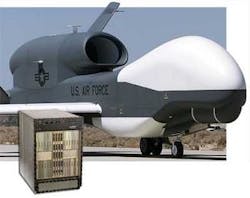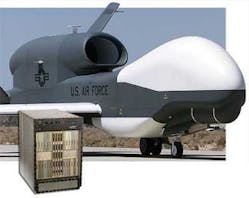By Ben Ames
CHELMSFORD, Mass. - When Air Force pilots steer the E-10A Joint Surveillance Target Arrack Radar System (Joint STARS) surveillance airplane near battlefields sometime after 2013, its powerful radar will track evasive cars and wagons through city streets, and simultaneously track low-flying cruise missiles.
That radar is called the Multi-Platform Radar Technology Insertion Program (MP-RTIP), and it relies on massive onboard computers.
Raytheon is building the active, electronically scanned array radar for its partner, Northrop Grumman. MP-RTIP is modular, so they will build a large version for the E-10A, a mid-sized version for NATO aircraft, and a small version for the Global Hawk unmanned aerial vehicle (UAV).
All the versions are powered by a crucial technology - powerful and efficient computers processing that data while it is being collected. Subcontractor Mercury Computer Systems of Chelmsford, Mass. is building the computers.
To handle the massive signal-processing load, Mercury engineers upgraded their PowerStream Multi-Port 410 computer, now used on the Joint STARS. The result is the PowerStream 7000, about eight times more powerful than its predecessor.
The PowerStream 7000 is a cube the size of a hotel room mini-refrigerator, with four strong fans blowing hot air out the top. It contains 24 slots with five processors each, running 120 PowerPC 7447 chips connected through a passive backplane with RapidIO switched fabric. It gets I/O bandwidth from 32 PMC or XMC cards. Altogether, the unit creates 1 trillion floating-point operations per second (1 TeraFLOPS) of processing power.
Stuffed with microprocessors, bridge chips, switches, and memory devices, the computer is so dense that designers worried about dissipating the heat. They used an approach called “managed air,” which forces cool air to flow through channels like water. With this method, PowerStream can cool 200 watts/slot.
“We make sure there’s no air molecule that’s wasted. We manage them as carefully as the electrons in the circuits,” says Barry Isenstein, vice president and general manager of the company’s Defense Electronics Group.
Cooling sounds boring but it is probably the number-one challenge restricting computer growth in general. Apple just released a liquid cooled chip, modeled after the way you cool your car.” In fact, he says, cooling is now the biggest hurdle to Moore’s Law, the dictum that engineers will find ways to double the number of gates on a processor every 18 months.
Density alone is not good enough for this job - the computer also has to be power-efficient. “It’s all about efficiency, turning watts into flops. You only get the power that’s left over from keeping the plane aloft,” says Jonathan Schonfeld, Segment Manager for Radar in Mercury’s Defense Electronics Group. FLOPS are floating point operations per second.
That is an even bigger challenge on smaller aircraft. While the full-size PowerStream 7000 rides on the E-10A’s adopted Boeing 767, a small version also processes radar signals on the Global Hawk UAV.
Pentagon leaders protect those expensive assets with long standoff distance, using altitude for the Global Hawk and range for the MC2A. The drawback is that distance increases the signal-to-noise ratio in the radar data, making a harder computing task.
But electronics designers can’t win, Isenstein says if those planes flew closer to the battlefield, they would need more defense systems, leaving less space and power for signal processing.
Across the industry, defense electronics makers face a similar set of technical challenges. “The industry is entering a period of dramatic change. The infrastructure that the meat of the market is using VME will have to change,” Isenstein says.
Three trends are hitting the defense electronics industry at once. First, engineers are changing designs from the parallel database to serial fabrics. As the change hits mainstream design, even processor manufacturers are putting fabric technology directly on the chips.
Second, says Isenstein, “The venerable old VME connector can’t do it; we need a new form factor.” The challenge for designers is how to keep current hardware compatible with the next generation. “If you’re a defense contractor launching a platform for 2006, you have to think long and hard about what to do. If you go with VME, you’re planning for a forklift upgrade.”
And third, chips are growing too hot. As standard processors get faster than ever, they also use more power. Some designers are using field programmable gate arrays instead of digital signal processors, but the challenge remains.
“All three factors are changing at once. That’s a lot of uncertainty, compared to the incremental improvements we’ve seen in VME over the past 15 years,” he says.
That is one reason that Mercury engineers changed from Race ++ to RapidIO when they upgraded the PowerStream 410. Both technologies are switched serial interconnects, but the new fabric provides more bandwidth per pipe, more pipes, and more efficient switching, says Isenstein.
Faced with the sheer number of pixels and moving targets on a modern battlefield, they needed to push the processors as fast as they could go. The E-10A will perform both surveillance and management of the battlefield, according to its full name, the Multi-sensor Command and Control Aircraft (MC2A).
“Joint STARS was looking at a small number of Soviet tanks, while today MC2A must keep track of every station wagon, every minivan, and every Mini Cooper. In the old days, missing one tank was not all that big a deal, but today you miss one missile launcher and that could blow up a city,” says Schonfeld.
That task gets even harder in the modern urban battlefield, since radar traditionally has good resolution along the line of sight, but needs heavy signal processing to get fine resolution images perpendicular to the line of sight.
“The trouble with urban surveillance at fine grain is that buildings get in the way,” Schonfeld says. And to add a final level of challenge, the mission of MC2A is to present that data as movies that show where the traffic is going, not just surveillance snapshots. Until the mid-1990s, designers couldn’t even refresh a screen often enough to display that data.
In April 2004, Air Force leaders awarded $888 million to Northrop Grumman for Phase II of MP-RTIP. Northrop Grumman designers are creating the Battle Management Command and Control (BMC2) architecture to control all the data. And in June, Northrop Grumman gave $369 million of that grant to Raytheon to build the radar and produce six MP-RTIP radar systems - three each for the E-10A and for Global Hawk. The new radar will enable airmen to simultaneously collect ground moving target imagery and synthetic aperture radar signals. It will also offer an air moving-target indicator, used to track cruise missiles.




